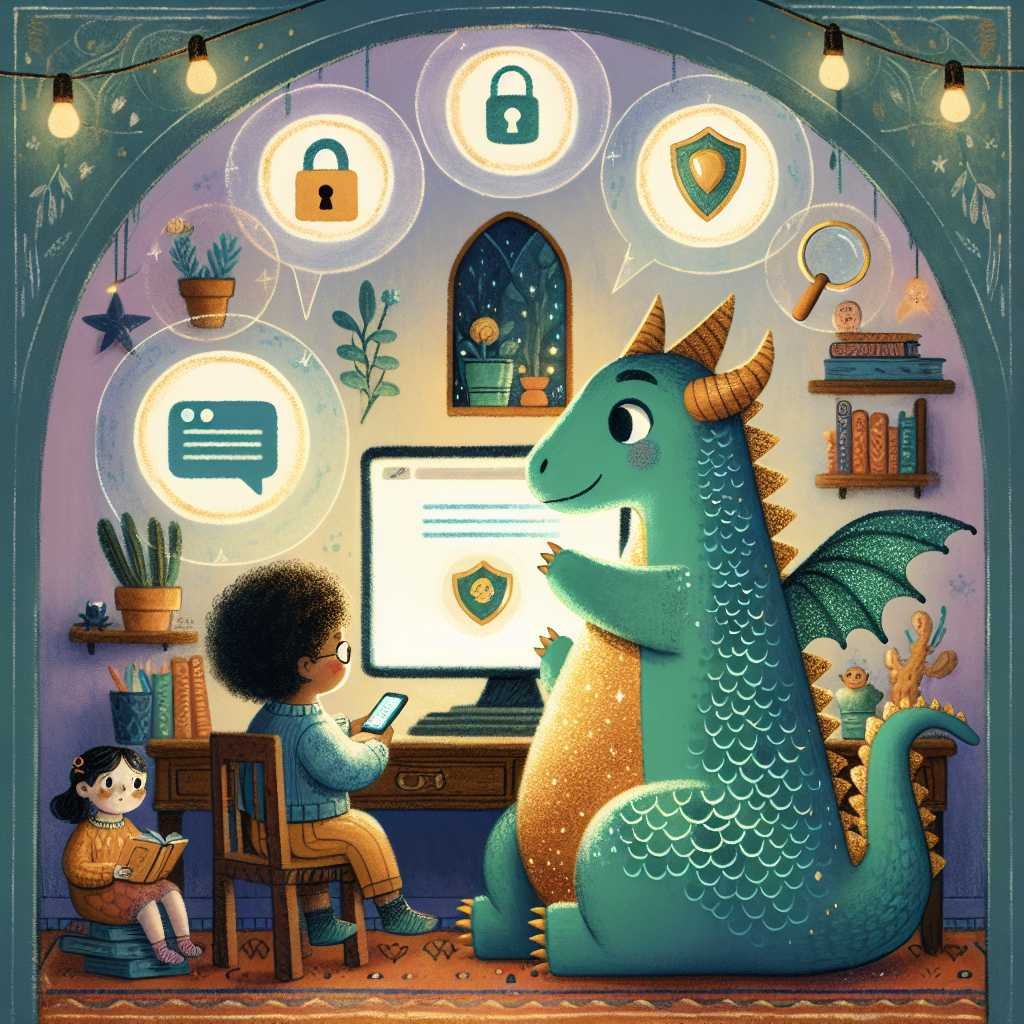Teach Your Dragon Online Safety: A Parent’s Guide to Raising Smart, Kind Digital Citizens
Your child’s world is part playground, part pixel. They hop from homework to gaming to videos to chats without missing a beat. But in a world where the next click can be a gift or a gotcha, you need more than rules—you need a story your child can feel. That’s where Teach Your Dragon Online Safety (My Dragon Books) shines: it turns big, abstract concepts into a playful journey kids can follow, remember, and use.
In this guide, we’ll unpack what makes story-based learning so powerful, walk through the digital dilemmas your child might face (and how Diggory Doo handles them), and give you ready-to-use scripts, conversation starters, and classroom ideas. You’ll leave with a practical framework to keep your child safe, confident, and kind online—without constant battles or fear.
Why Story-Based Learning Works for Online Safety
The online world is huge and hard to explain. “Don’t click that” or “Be careful” doesn’t stick. Stories do. When kids meet Diggory Doo—a dragon who loves games, videos, and making friends online—they see themselves. They learn through his choices. They imagine what they would do.
Here’s why that matters: – Stories lower defenses. Kids process guidance without feeling lectured. – Characters model behavior. Children practice decisions in a “safe” world first. – Repetition builds memory. Key lessons recur across chapters and scenes. – Emotions glue learning. A tense moment, a surprise twist—these make lessons unforgettable.
Curious which story sparked our chat? Check it on Amazon.
Inside the Story: Diggory Doo’s Digital Dilemmas (and What to Do)
The beauty of Teach Your Dragon Online Safety is that it covers the moments you’re most worried about—but in a child-friendly way. Let’s break down the core dilemmas and translate them into simple strategies you can teach today.
1) Personal Information: What’s Shareable (and What Isn’t)
Diggory gets a “friend” request from someone he met in a game. Seems nice. But they ask what school he goes to and for a selfie. Red flags fly.
Teach your child: – Public vs. private: Name, age, school, phone number, address, passwords, and even photos with school logos are private. – The “Grandma Rule”: If you wouldn’t show it to Grandma and your principal at the same time, don’t post it. – The “Ask First” habit: If someone asks for personal info, pause and check with a grown-up.
For more on privacy basics, the FTC’s parent guide is a great resource: Protecting Your Child’s Privacy Online.
2) Algorithms and Distressing Content: When the Feed Goes Dark
Diggory clicks a silly video. The next one autoplayed is edgy. Then scary. He can’t unsee it—and that’s the point. Algorithms chase watch time, not well-being.
Teach your child: – It’s not your fault you saw it. Algorithms guess, often wrong. – Three steps: Stop the video, tell a grown-up, and switch to a “safe” source or activity. – Use platform tools: Turn off autoplay, report inappropriate content, and block channels.
Common Sense Media offers platform-specific tips and ratings: Common Sense Media.
3) Stranger Danger 2.0: Gaming Chats and Friend Requests
A “mysterious friend” compliments Diggory’s gaming skills and asks for a DM. Feels good. But flattery can be a tactic.
Teach your child: – A friend is someone you know in real life. Everyone else is an online contact. – Never move conversations to private DMs without a parent’s OK. – If someone asks for photos, gifts, or secrets—end the chat and tell a grown-up.
NetSmartz has age-appropriate videos you can watch together: NCMEC NetSmartz.
Want a tool you can read tonight to start the conversation? Buy on Amazon.
4) In-App Purchases: The “Free” Game That Isn’t
Diggory loves upgrades and skins. Suddenly the charges add up. He didn’t realize “just one more” could cost real money.
Teach your child: – Money is real online. Even coins and gems can require dollars. – Ask-first rule for purchases, downloads, and subscriptions. – Use device settings to require approval for purchases and prevent unauthorized transactions.
5) Digital Footprint: Posts Last Longer Than Feelings
Diggory posts a silly meme that insults a classmate. Laughs appear. Then feelings get hurt. He learns: posts have power.
Teach your child: – The “24-hour rule”: If you’re upset, wait a day before you post or reply. – Future-you test: Would future-you still be proud of this? – Kindness beats clever. If in doubt, don’t post.
Check out the federal resource on cyberbullying: What Is Cyberbullying.
6) Balance and Boundaries: When Screens Crowd Out Life
Diggory loses track of time. He’s cranky, sleep-deprived, and skipping activities he once loved. Time to reset.
Teach your child: – Set “screen zones” and “no-screen zones.” Bedrooms and dinner tables are great no-screen zones. – Create a family media plan together. It works best when kids help set the rules. – Replace, don’t just remove: Offer offline alternatives—soccer in the yard, building blocks, drawing, or reading.
Use the American Academy of Pediatrics tool to make a custom plan: Family Media Plan.
A Simple, Memorable Framework Kids Will Use
Here’s a five-part framework to keep next steps easy and consistent.
1) Stop-Think-Ask – Stop: Don’t click right away. – Think: Is it private, kind, safe, and true? – Ask: Check with a trusted adult if you’re unsure.
2) The Five W’s of Sharing – Who will see it? – What does it reveal? – Where will it live (platform, permanence)? – When is the right time? – Why share it at all?
3) Friend or Fake? – Real friends are known in real life. – Gifts, secrets, and flattery can be warning signs. – When in doubt, log out and tell.
4) Money Matters – Games may be free; upgrades are not. – Ask-first for anything that costs money. – Set device-level purchase approvals.
5) Balance Beats Burnout – Schedule screen-free times and places. – Use timers or visual cues. – Swap in offline fun, not just “no.”
Choosing the Right Online Safety Book for Your Child
Not all safety books are created equal. Here’s what to look for when you’re deciding what belongs on your shelf.
- Age fit: Check the target age and reading level. Early elementary kids need bright visuals and simple sentences. Older kids can handle nuance and examples from social media.
- Tone and warmth: Look for an empowering voice. Fear-heavy books can shut kids down; hopeful guides keep them engaged.
- Diversity and relatability: Characters that mirror your child—or your classroom—help kids see themselves in the lesson.
- Practical tools: Conversation prompts, checklists, and reflection questions make lessons stick.
- Re-read value: Do you find something new on the second or third read? That’s a keeper.
- Durability and design: Sturdy pages, clear layout, and engaging art matter for repeat use.
If you’re comparing kid-friendly internet safety books, View on Amazon to see reader reviews and age range.
Build Your Home’s Digital Safety Net
Books spark great conversations. Systems make them stick. Pair Diggory’s lessons with a few smart tools.
- Use parental controls and filters: Set age ratings on streaming apps, block explicit content in search, and require purchase approval.
- Turn off autoplay: Reduce accidental exposure to distressing videos.
- Create a “tech parking spot”: Devices charge outside bedrooms overnight to protect sleep.
- Practice “phishing drills”: Show kids sample messages and ask, “What clues say this is a trick?” This guide is helpful: Avoiding Social Engineering and Phishing Attacks.
- Check privacy settings together: Walk through games and apps side by side. Let your child adjust settings so they own the change.
- Use content reviews: Before kids try a new show, game, or app, look up reviews on Common Sense Media.
Ready to add a screen-time conversation starter to your bookshelf? See price on Amazon.
Conversation Scripts You Can Use Tonight
Some moments feel tricky in real time. Use these quick scripts to lower the heat and raise the learning.
- When your child saw a scary video:
- You: “Thanks for telling me. That was a good choice. Let’s take a breath, turn off autoplay together, and pick a channel we trust.”
- When a stranger asked for info:
- You: “That’s not your fault—it was a pressured ask. Online ‘friends’ are not the same as real friends. Let’s block and report, then tell the game why.”
- When your child posted something unkind:
- You: “It takes courage to fix a mistake. Let’s delete it, apologize privately, and think of a post that spreads kindness instead.”
- When in-app purchases got out of hand:
- You: “Happens to lots of kids. I’m going to set approvals. You’ll ask first, and we’ll decide together what’s worth it.”
- When screen time is taking over:
- You: “We’re going to try a new plan that protects sleep and fun. What offline activities do you want to add this week?”
Classroom and Counseling Ideas: Turn the Book into a Mini-Unit
Educators and counselors can use Teach Your Dragon Online Safety as a low-lift, high-impact lesson plan. Here’s a simple flow that fits a 30–45-minute session.
- Warm-up (5 min): “Two Truths and a Trick.” Present three online scenarios; students guess which one is risky and why.
- Read-aloud (10–15 min): Pause at key moments to ask, “What would you do next?” Capture ideas on a whiteboard.
- Small groups (10 min): Each group gets a scenario card (stranger in a game, in-app purchase, hurtful post). They brainstorm the Stop-Think-Ask steps.
- Share-out (5 min): Groups present their solution and one prevention tip.
- Reflection (5 min): Students write one sentence: “One thing I’ll do differently online is…”
Prefer to support our work while getting a helpful resource? Shop on Amazon.
Turn Lessons Into Habits: Micro-rituals That Stick
Habits beat lectures. Try these lightweight routines at home or school:
- The “Ask Basket”: A sticky note on the fridge or a shared doc where kids drop questions or weird things they saw online.
- Friday Media Check-in: 10 minutes to review one new setting, one new app, and one good thing seen online.
- Three-Click Rule: If you find something upsetting, stop after three clicks and get help.
- Compliment Challenge: Post one kind comment a day. Model it yourself.
- Device “Goodnight”: Set a time when devices go to their charging spot. Read together—even one page.
What This Book Gets Right (and Why It Matters)
- It centers empathy. Kids see why kindness online is power, not weakness.
- The dragon metaphor works. Distance makes tough topics feel safe and manageable.
- It covers the full spectrum. Privacy, strangers, money, content, and balance—without scaring kids.
- It invites conversation. You’ll find natural pause points to ask, “What would you do?”
Want a ready-made story to kick off your family’s media plan? Check it on Amazon.
Safety FAQs Parents Ask (And Honest, Useful Answers)
Q: What’s the right age to talk about online safety? A: Start when your child starts using connected devices—even if that’s just watching videos with you. Keep it simple at first: “Ask before you click.” Then add layers as they grow.
Q: How do I set screen time limits without a battle? A: Co-create a plan. Kids comply better with rules they helped build. Use the AAP’s Family Media Plan and agree on no-screen zones (like bedrooms) and screen-free times (like dinner).
Q: What should I do if my child saw disturbing content? A: Stay calm. Thank them for telling you. Validate their feelings. Turn off autoplay, block the source, and switch to approved channels. Keep an eye on sleep and mood. If nightmares or anxiety persist, talk to your pediatrician or school counselor.
Q: How do I explain phishing and scams to a young child? A: Use simple clues: “If someone offers a prize, asks for secrets, or spells things weird, it’s probably a trick.” Do quick drills using examples from CISA’s phishing guidance.
Q: Is social media ever okay for elementary-age kids? A: Most platforms set age 13+ for a reason (privacy laws and maturity). If your child wants to “post,” try a private family photo stream or a shared album you control. Teach the habit; delay the platform.
Q: My child was mean online. How do I fix it? A: Treat it as a learning moment. Have your child delete the post, apologize, and make amends. Discuss impact, not just consequences. Reinforce the “24-hour rule” for future posts and review kindness norms.
Q: Which parental controls should I use? A: Start with built-in settings on your device and apps, enable content filters, and require purchase approvals. Pair controls with coaching—filters help, but your child’s judgment is the long-term goal. Check reviews on Common Sense Media for platform-specific tips.
Q: How do I teach my child to ask for help when something feels off? A: Normalize asking. Praise them when they do. Practice scripts: “I saw something weird,” “Someone asked for my info,” “I think I clicked the wrong thing.” The more familiar the words, the easier the moment.
Q: What if my kid says “You don’t trust me” when I set limits? A: Try, “I trust you. I don’t always trust the internet. My job is to protect you while you learn. Let’s set rules together and revisit them in a month.”
Q: Where can I find more kid-friendly lessons? A: Explore NetSmartz for videos and activities, Common Sense Media for curricula and app reviews, and StopBullying.gov for cyberbullying resources.
Final Takeaway
Online safety isn’t a one-time talk—it’s a rhythm you build at home and school. A story like Teach Your Dragon Online Safety makes the hard parts easier because it gives kids a friendly guide and you a shared language: Stop-Think-Ask, Friend or Fake, Balance Beats Burnout. Pair the book with a simple media plan, practice quick scripts, and revisit the conversation often. If you found this helpful, stick around for more parent-first guides and classroom-ready resources—we’re here to make raising digital citizens feel doable, hopeful, and even a little fun.
Discover more at InnoVirtuoso.com
I would love some feedback on my writing so if you have any, please don’t hesitate to leave a comment around here or in any platforms that is convenient for you.
For more on tech and other topics, explore InnoVirtuoso.com anytime. Subscribe to my newsletter and join our growing community—we’ll create something magical together. I promise, it’ll never be boring!
Stay updated with the latest news—subscribe to our newsletter today!
Thank you all—wishing you an amazing day ahead!
Read more related Articles at InnoVirtuoso
- How to Completely Turn Off Google AI on Your Android Phone
- The Best AI Jokes of the Month: February Edition
- Introducing SpoofDPI: Bypassing Deep Packet Inspection
- Getting Started with shadps4: Your Guide to the PlayStation 4 Emulator
- Sophos Pricing in 2025: A Guide to Intercept X Endpoint Protection
- The Essential Requirements for Augmented Reality: A Comprehensive Guide
- Harvard: A Legacy of Achievements and a Path Towards the Future
- Unlocking the Secrets of Prompt Engineering: 5 Must-Read Books That Will Revolutionize You







